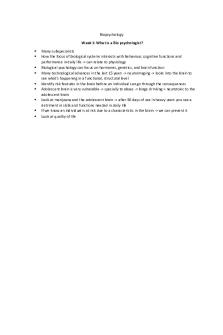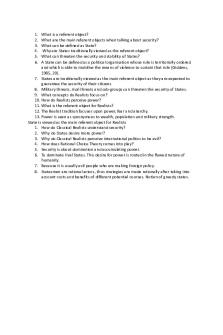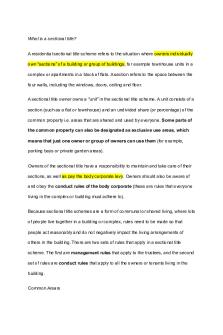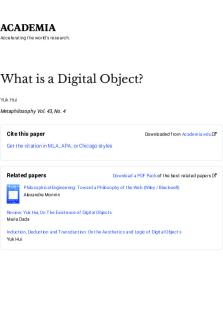MKT 3007 - Critically discuss what is meant by a culture of consumption PDF

| Title | MKT 3007 - Critically discuss what is meant by a culture of consumption |
|---|---|
| Author | Tom Hoodeh |
| Course | Marketing |
| Institution | University of Northampton |
| Pages | 14 |
| File Size | 245.8 KB |
| File Type | |
| Total Downloads | 96 |
| Total Views | 132 |
Summary
3rd year MKT 3007 mandatory assignment...
Description
! (
(
CRITICALLY(DISCUSS(WHAT(IS( MEANT(BY(A(“CULTURE(OF( CONSUMPTION”?( ( USE(RELEVANT(EXAMPLES(TO(SUPPORT(YOUR( ANSWER.(
( ( Ramin(Tom(Hoodeh(5(13433627(
University*of*Northampton* MKT*3007*|*Assignment*2*
(Eaton,(2007)(
Ramin!Tom!Hoodeh!! 13433627! ! (
! !
MKT!3007!–!Consumer!Behaviour!–!AS2! University!of!Northampton!
Critically( discuss( what( is( meant( by( a( “culture(of(consumption”?(( Use(relevant(examples(to(support(your(answer.( ( “Consumer(culture(denotes(a(social(arrangement(in(which(the(relation(between(lived(culture( and(social(resources,(between(meaningful(ways(of(life(and(the(symbolic(and(material(resources( on( which( they( depend,( is( mediated( through( markets”( (Slater,( 1997,( p.( 6).( Since( the( 20th( century,( globalisation( and( advancements( in( technology( have( enabled( the( mass( production,( transport(and(consumption(of(desirable(goods(on(the(largest(scale(seen(in(human(history((The( Economist,(2009).(The(demand(for( such(goods(is( arguably(the(result( of(the(work(of(Edward( Bernays,(referred(to(as(“the(father(of(public(relations”((NY(Times(,(1995).(In(the(1930s,(Bernays( utilised(his(uncle(Sigmund(Freud’s(work(on(psychoanalysis(to(unleash(humans’(dormant(desire( for( material( goods.( New( marketing( tactics,( philosophies,( advertisement( tools( and( branding( have(since(been(developed(to(stimulate(the(global(homogenous(marketplace(in(which(a(culture( of(consumption(expresses(itself(in.( Bernays’s( use(of(what(he(called(“enlightened(despotism”( would(appeal(to(people’s(unrecognised(longings(for(self5expression.(Bernays(was(the(first(to( experiment(with(celebrity(endorsement,(for(women,(he( was(the(first(to(market( a(dress(as(a( symbol(of(expressing(their(inner5self(to(others((Century(of(the(Self,(2002).( As(recent(history( shows(the(transition(to(a(consumer(society,(there(is(evidence(to(show(that(mass(consumption( plays( a(role( in( constructing(individuals’( and(the( collective(identity( (Zukin( &(Maguire,( 2004).( Today’s(culture(of(consumption(acts(as(a(medium(in(which(people’s( meaning(is(sought,(and( identity( is( created( (Dittmar,( 2007).( This( essay( will( clarify( some( theoretical( underpinnings( behind(how(the(culture(of(consumption(was(developed( and(therefore(gain(a(deeper(insight( into(what(it(is(today.( ( Maslow’s( (1943)( seminal( work( on( human( physiological( needs,( claims( that( everything( that( humans(do(is(because(of(their( yearning(to(achieve(self5actualisation;(to(eventually(get(to(an(
Ramin!Tom!Hoodeh!! ! MKT!3007!–!Consumer!Behaviour!–!AS2! 13433627! ! University!of!Northampton! ! ultimate( level( of( satisfaction( and( content( (Maslow,( 1943).( This( can( be( seen( as( the( inner( workings(of( the(human(mind( and(can( help( in(explaining(the( demand(of(mass( consumption.( Osho,(as(a(world(renowned(spiritual(leader,(gave(an(interpretation(of(Maslow’s(claims.(Osho( claims( that( if( humans( aren’t( aware( of( their( instincts,( their( whole( life( will( be( a( struggle( in( attempting( to( be( satisfied( (Osho,( 2010).( Maslow( articulates( a( similar( approach( through( his( “hierarchy( of( needs”( model.( The( model( prioritises( physiological,( safety,( love/belonging,( esteem(and(self5actualisation(as(5(basic(human(needs((Maslow,(1943).((In(a(capitalist(context,( many( of( these( needs( require( the( purchase( of( goods( and( services,( which( maintain( the( “consumption( culture”.( This( introduces( the( link( between( innate( and( inherent( human( tendencies( and( how(they( resulted( in( a( culture(of( consumption.( Furthermore,( analysing( the( initial( causes(for(humans’(modern(consumption(culture( could(lead(towards(gaining(a(deeper( understanding(of( what(consumption( culture(is.( This(theory( could( look(at( how( some( deeper( human(desires(fuel(the(industry(to(be(what(it(is(at(the(present(and(possibly(where(the(global( consumerist( industry( could( be( in( the( future.( This( could( present( a( new( perspective( in( understanding(consumption(culture.(( ( Fashion(consumption(is(a(central(faucet(of(consumption(culture,(accounting(for(around($1.5( trillion(each(year((B.o.F.(,(2013).(Significantly,(fashion(has(always(been(synonymous(with(human( development,(and(looking(at(very(primitive(consumption(related(to(fashionable(items(may(help( clarify( what( makes( the( modern5day( culture( of( consumption.( The( general( view( of( the( first( instance( of( clothing( is( arguably( taken( from( the( “Flintstones”( stereotype( of( Stone5Age( men( wearing(the(skin(of(animals(as(hides(and(capes((IMDb,(2016).(However,(archaeological(findings( show( that( this( “Flintstone”( representation( of( cavemen( is( simplified( and( in( fact,( out5dated( (Gilligan,(2010).(Gilligan(theorised(that(such(clothing(would(obscure(tactile(sensation,(a(crucial( part(of(mammalian(development(as(it(could’ve(risked(fundamental(social(and(environmental( relationships((Gilligan,(2010).(This(suggests(a(more(complex(view(of(very(early(human(clothing( phenomena.( ( Gilligan( describes( some( findings( of( ambiguous( fashionable( items( of( clothing( dating( back( to( 100,000(years(ago.(One(example(of(an(archaeological(recorded(discovery(of(ornamental(shell( beads(in(Africa(dating(to(100,0005110,00BC.(These(have(been(widely(construed(as(evidence(for(
Ramin!Tom!Hoodeh!! ! MKT!3007!–!Consumer!Behaviour!–!AS2! 13433627! ! University!of!Northampton! ! the(emergence(of(modern(human(behaviour(and(symbolic(thinking(in(the(middle5stone5ages( (Gilligan,(2010).(Indeed,(fashion(seems(to(complement(different(stages(of(human(development( and(civilisation.(The(origins(of(fashion(consumption,(rather(than(being(externally(marketed(and( persuaded(into(society,(seems(to(stem(from(a(process(inherent(in(humans(that(makes(clothing( fashion( appealing.( Pin5pointing( the( reasoning( behind( this( inherent( appeal( can( help( further( understand(what(a(main(part(of(modern5day(consumption(culture(is.((( ( This(inherent(appeal(is(also(seen(in(ancient(tribes;(a(variety(of(which(still(exist(globally.(They( represent(a(somewhat(synonymous(link(to(prehistoric(humans(from(hundreds(and(thousands( of( years( ago.( The( oldest( known( tribe( (70,000( years)( are( the( Great( Andamese( whose( last( remaining(survivor(died(6(years(ago((National( Geographic,(2010).(These(tribes(can(be(vastly( different(to(modern(day(humans;(for(example,(the(Amondawa(tribe(in(Brazil(lived(without(any( abstract(idea(of(time((BBC,(2011).(However,(some(tribes(do(present(some(similarities(that(may( help(explain(the(abundance(of(modern5day(consumption(phenomena.(Since(their(environment( was(vastly(different,(spotting(similar(consumption5related(behaviours(can(pin5point(inevitable( phenomena(which(can(be(used(to(further(understand(consumption(culture(in(the(21st(century.( The(Andamese(tribe(for(example(showed(an(appreciation(for(jewellery(and(different(hair(styles( (Abbi,(2016).(Their(women(used(pandanue(leaves(to(make( belts,(attaching(more(leaves(and( bark(to(cover(their(breasts.(The(men(also(wore(these(belts(–(they(didn’t(cover(their(breasts,( but(rather(decorated(themselves(with(small(shells((Andaman(Beacon,(2016).(This(can(suggest( that(inter5gender(fashion(isn’t(a(modern5day(consumerist(social(construct;(it(is(an(inevitable( phenomenon( of( human( behaviour.( Interestingly,( boys( in( the( tribe( wore( long( trousers( and( shirts,(whereas(men(wore(shorts(and(vests((Andaman(Beacon,(2016).(This(shows(that,(much( like(with(uniform(and(the(commonly(accepted(types(of(clothing(in(the(1920s((Century(of(the( Self,(2002),(humans(have(long(used(clothing(to(accommodate(a(persons’(place(in(society.(The( use( of( clothing( to( indicate( a( persons’( place( in( society( seems( an( inevitability( of( human( behaviour.( ( This( could( explain( the( inner,( subconscious( workings( behind( the( culture( of( consumption.(Additionally,(since( decorative(clothing( was( used(to( accentuate(an( individual’s( beauty,( a( logical( conclusion( would( be( that( consumption( culture( is( and( was( also( fuelled( by( human(sexual(desire.(This(is(similar(to(the(Bernays5era(interview(of(the(first(woman(in(America(
Ramin!Tom!Hoodeh!! ! MKT!3007!–!Consumer!Behaviour!–!AS2! 13433627! ! University!of!Northampton! ! seen(wearing(a(short(skirt(–(when(asked(why(by(an(interviewer(she(replied(“because(it(makes( you(look(more(attractive”((Century(of(the(Self,(2002).( ( Ideals(are(another(reoccurring(phenomenon(through(human(history.(Ideals(are(referred(to(in( the(context( of(a( standard(or(principle( to(be( aimed(at((Cambridge( ,(2016).( Society(creates( a( perfect(standard,(which(causes(humans(to(take(action(in(order(to(get(closer(to(that(ideal.(This( is(reminiscent(of(Maslow’s(use(of(the(term(“self(actualisation”((Maslow,(1943).(Ironically,(self5 actualisation(is(impossible(through(consumption(practices((Burroughs(&(Rindfleisch,(2002),(but( nevertheless( humans( still( engage( in( such( a( behaviour.( Humans( have( long( created( ideals( throughout(history;(the(“Herculean”(body((that(the(ancient(Greek(associated(with(social(status( because( of( their( gladiator( fascination( (Sennett,( 1996)( was( an( ideal.( The( Ancient( Greeks( associated(a(beautiful(mind(with(a(beautiful(body((BBC,(2015).(Another(example(is(the(Indian( and( Middle(Eastern( appreciation( of(lighter( skin.( It( is(claimed( that(lighter( skin( is(idealised( in( these(cultures(because(those(with(lighter(skin(have(indoor(jobs;(they(don’t(spend(as(much(time( as( labourers(outdoors( in(the( Sun,( therefore(they( are( more(valuable/successful( members( of( society((Guellaty,(2013).(Another(ideal(is(where(female(Surma(tribes(in(Ethiopia(pierce(their( lips(with(large(plugs;(the(bigger(the(plate(radius,(the(more(the(tribe(considers(the(woman( as( beautiful( (Scully( &( Chen,( 1993).( This( shows( that( although( fashion( ideals( change( over( generations/cultures,(the(existence(of(ideals(of(what(is(considered(beautiful(has(always(been( inherent( in( humans.( This( involves( how( humans( use( ideals( to( appeal( to( the( opposite( sex.( Remarkably,(all( ideals( attach(themselves( with(social( status(–( the(more( an(individual( fit(that( society’s(current(ideal,( the(more( status(they(had.( (In( the(21st(century,( one(can(argue( that(a( person’s(value(is(reminiscent(of(their(wealth.(Corneo(&(Jeanne((1997)(discuss(how(the(desire( for(social(status(lead(individuals(to(care(about(their(relative(wealth((Corneo(&(Jeanne,(1997).( The( vice( versa( also( applies,( therefore( it( can( be( said( in( this( current( era,( being( wealthy( and( successful(is(idealised.(( ( A(study(by(O’Cass((2004)(researched(the(primary(characteristics(of(status5seeking(consumers( and(those(who(“conspicuously”(consume(brands((O'Cass,(2004).(O’Cass(refers(to(Kilsheimer’s( definition( of( status( consumption( to( clarify( how( conspicuous( consumption( is( a( result( of( consumers(buying(out(of(the(desire(for(status.(Kilsheimer((1993:(341)(articulates(this(as(“the(
Ramin!Tom!Hoodeh!! ! MKT!3007!–!Consumer!Behaviour!–!AS2! 13433627! ! University!of!Northampton! ! motivational( process(by(which(individuals(strive(to(improve(their(social(standing(through(the( conspicuous(consumption(of(consumer(products(that(confer(and(symbolise(status(both(for(the( individual( and( surrounding( significant( others”.( This( gives( further( meaning( to( the( culture( of( consumption;( since( social( status( is( an( inherent( phenomenon( of( interpersonal( human( behaviour,(and(consumption(culture(allows(people(to(improve(status,(such(a(culture(too(will( remain(an(inevitability(in(human(civilisation.(( ( An(insight(into(human(motivation(can(help(explain(status(consumption(and(therefore(pin5point( what(fuels(consumption(culture.(Motivation(is(often(expressed(in(terms(of(a(“drive”(or(some( goal5orientated( behaviour.( Arousal( is( a( component( of( motivation,( Touré5Tillery( &( Fishbach( (2011)(use(the(example(of(viewing(motivation(as(a(mis5match(between(a(consumer’s(present( state(and(their(desired(state((Touré5Tillery(&(Fishbach,(2011).(Such(goal5orientated(behaviour( is( found( in( Kivetz( et( al.( (2006)’s( experiment( with( “frequent5buyer( programs”.( In( a( reward( where,(for(example,(a(consumer’s(8th(purchase(is(heavily(discounted,(Kivetz(et(al.((found(that( consumers(accelerated(their(rate(of(purchases(the(closer(they(got(to(that(8th(purchase((Kivetz,( et( al.,( 2006).( Touré5Tillery( &( Fishbach( compare( this( with( an( analogy( from( Hull’s( (1934)( experiment.( Hull(compared(goal5orientated(behaviour(with(that(of(rats(and(their(increase(in( running( speed( the( closer( they( got( closer( to( some( food( at( the( end( of( an( alley( (Hull,( 1934).(( Comparing( the( behaviour( of( humans( to( rats( introduces( the( theories( that( point( towards( consumption(culture(being(driven(by(animalistic(influences.(( ( Parker(&(Tavassoli((2000)(utilise(the(biological(term,(homeostasis,(to(articulate(the(feeling(of( unpleasantness(one(experiences(if(their(consumption(needs(are(not(met.(They(claim(that(goal5 orientated( behaviour( is( activated( through( marketing5related5homeostasis,( to( minimise( this( unpleasant( state( and( return( to( a( neutral( one( (Parker( &( Tavassoli,( 2000).( Such( animalistic( behaviour(can(be(ascribed( to(the( limbic,(mammalian(part( of(the(human( brain(–( this(further( justifies( the( analogy( with( Hull’s( (1934)( rat( experiment.( Fugate( (2007)( claims( that( humans’( desire(for(instant(gratification(operates(from(“the(more(primitive(limbic(region(and(behaves(in( an(emotional,(selfish(and(largely(irrational(way”((Fugate,(2007,(p.(390).(He(explains(how(factual( information(is(influenced(by(emotional(feelings,(and(therefore(marketers(utilise(the(pulling(of( emotional(strings(when(advertising(a(product.(The(context(of(Fugate’s((2007)(literature(is(in(
Ramin!Tom!Hoodeh!! ! MKT!3007!–!Consumer!Behaviour!–!AS2! 13433627! ! University!of!Northampton! ! the(field(of(Neuromarketing,( and(thus(he( continues(explaining(how( humans(have(a( physical( release(of(the(pleasure(chemical,(dopamine,(when(presented(with(a(desirable(product((Fugate,( 2007).( Consequently,( Neuromarketing( continuously( validates( authors’( theories( behind( how( deeper(biological(underpinnings(make(consumption(culture(remarkably(synonymous(to(human( civilisation.( ( The( roots( of( consumption( culture(also( relates( to( archaeological( findings,( particularly( in( the( Neolithic(era(that(showed(the(dawn( of(human(agricultural(practices(some( 10,000(years(ago( (Olsson,(2001,( p.(1).( Astoundingly,(this( presents(a( historical,(anthropological( perspective(on( consumption(culture,( in(the( context(of( status(consumption.( Agricultural(practices(created( a( new(accelerated(demand(for(possessing(resources;(tools,(permanent(shelter(and(territory(over( land.(Dyble((2015)(claims(that(this(era(stirred(greater(inequality(between(males(and(females(–( the( survival( advantage( of( possessing( resources( became( much( greater( than( that( of( hunter5 gatherer(predecessors((The(Guardian,(2015).(Since(this(was(concurrent(with(current(polygamy( of( humans( at( the( time,( a( competitive( environment( was( created( (Crane,( 2013).( If( several( females(shared( one(male,( and(possessing(items( presented(a( survival(advantage,(this( meant( that( the( males( with( greater( heterosexual( attraction( were( the( ones( with( the( drive( and( competence(to(possess(the(best(and(most(useful(items.(Bering((2014)(provides(further(reason( behind( this( phenomena,( referring( to( “parental( investment( theory”.( He( theorises( that( since( females( are( at( a( greater( risk( when( mating( with( another( male( (carrying( the( offspring( for( 9( months)( they( become( more( particular( with( their( choice( of( male.( This( could( present( a( new( perspective( on( why( males( have( the( desire( to( purchase( new( products.( The( Neolithic( era( presented(a(significant(psychological(change(in(human(development;(females(since(favoured( males( with(the( best(resources( as(it( represented(their( value(in( taking(care( of(their( offspring( (Bering,( 2014).( This( could( be( the( reason( behind( the( limbic( brain’s(dopamine( reward( in( the( purchase( decision( process,( mentioned( by( Fugate( (2007).( Evolutionary5based( human( development(can(also(help(explain(the(drivers(behind(conspicuous(and(status(consumption.( Pettit(&(Sivanathan((2010)(describe(how(individuals(consume(in(order(to(display(their(wealth,( perhaps(the(Neolithic(era(presented(the(evolutionary(underpinnings(in(the(human(psyche(to( manifest(such(a(behaviour.(They(also(discovered(that(consumers(with(lower(income(are(more( likely(to(spend(a(larger(proportion(of(their(income(on(status(consumption,(and(also(found(that(
Ramin!Tom!Hoodeh!! ! MKT!3007!–!Consumer!Behaviour!–!AS2! 13433627! ! University!of!Northampton! ! consumers(buy(because(they(have(lower(self5esteem((Pettit(&(Sivanathan,(2010)(–(so(therefore( their( goal5orientated( behaviour( drives(them( to( buy( and( increase( their( self5esteem.(( Finally,( perhaps( the( thousands( of( years( of( polygamy( in( human( history( can( give( reason( to( why( consumers(buy(out(of(low(self5esteem.(If(one(man(shared(many(females,(this(meant(that(many( males( were( left( without( a( sexual( partner,( so( indeed( it( may( be( possible( that( competitive( aggression( is( what( drives( purchase( consumption( and( contributes( consumption( culture( as( a( whole.(( ( Referring(back(to(Maslow’s(hierarchical(model(of(human(needs,(one(can(interpret(the(above5 mentioned( goal5oriented( theories( by( considering( the( goal( as( wanting( to( fulfil( the( aforementioned(psychological(needs,(which(leads(to(consumption(culture.(However,( Gabriel( &( Cianci( (2003)( claim( that( Maslow’s( explanation( is( too( simplistic.( They( argue( that( not( all( products(or(services(can(satisfy(human(needs((Gabriel(&(Cianci,(2003).(Ryan(&(Deci’s((1997)( self5determination( theory( corresponds(to( Cianci( &( Cambrel’s( criticism,( they( concluded(that( competence,(autonomy(and(relatedness(are(the(three(innate(needs(humans(have.(Ryan(&(Deci( determined(that( when(these(three(factors(are(met,( they(enhance(self5motivation,(and(when( thwarted(they(diminish(motivation( (Ryan(&(Deci,(2000).(The(competence(factor(strengthens( the( argument( that( instinctive( competitive( behaviour( plays( a( large( role( in( constructing( consumption( culture.( When( Ryan( &( Deci(claim( that( human( motivation( is( suppressed( when( those(needs(aren’t(met,(this(also(corresponds(to(Pettit(&(Sivanathan’s((2010)(claims(that(low5 self(esteem(leads(to(further(compulsive(buying.(Indeed,(consumption(culture(acts(as(a(means( for(people( to(satisfy( their(needs(for( achievement(and( thus(helps(explain( why(products( that( signify(success((status(consumption)(are(consumed.(Perhaps(this(need(for(achievement(is(what( Maslow( theorised( about( self5actualisation.( Relatedness( is( another( significant( factor( Ryan( &( Deci( (1997)( pointed( out( which( refers( to( human’s( longing( for( a( sense( of( belonging,( and( connectedness(with(others.(Corneo(&(Jeanne((1997)(mentioned(how(relative(wealth(is(linked( to(social(status,(so(consequently(people’s(yearning(for(social(status(could(be(the(way(in(which( they(express(their(longing(for(relatedness.(Therefore,(humans’(feeling(of(relatedness(could(be( a(cause(of(consumption(culture,(and(an(understanding(of(this(may(help(to(further(articulate( what(a(culture(of(consumption(is.(( (
Ramin!Tom!Hoodeh!! ! MKT!3007!–!Consumer!Behaviour!–!AS2! 13433627! ! University!of!Northampton! ! Hofstede(defines(culture(as(the(“collective(programming(of(the(mind”((Hofstede,(1991,(p.(2).( The(culture(of(consumption(therefore(contextually(insinuates(that(humans(are(programmed( to(consume.(Perhaps(people’s(psychological(desires,(such(as(relatedness,(can(be(seen(as(the( programming(code(behind(consumption(practices(and(therefore(articulate(what(a(culture(of( consumption( is.( Mafessoli’s( (1996)( perspective( on( the( disintegration( of( mass( culture( corresponds( to( this( assumption.( Mafessoli’s( work( can( be( seen( as( pin5pointing( the( ways( in( which( consumers( express( their( psychological( desires.( He( helps( to( clarify( any( blurred( or( generalised( theories( behind( consumption( c...
Similar Free PDFs

What is Culture - Essay Paper
- 6 Pages

Critically discuss R v Brown
- 2 Pages

What is a Biopsychologist
- 1 Pages

Culture is destiny a conversat
- 7 Pages

What is a referent object
- 1 Pages

What is a social fact
- 2 Pages

What is ABA - Grade: A
- 5 Pages

What is race - Grade: A
- 1 Pages

What is a sectional title
- 4 Pages

What is a summary judgement
- 5 Pages

What is a product - lecture
- 4 Pages

What is a Digital Object?
- 17 Pages
Popular Institutions
- Tinajero National High School - Annex
- Politeknik Caltex Riau
- Yokohama City University
- SGT University
- University of Al-Qadisiyah
- Divine Word College of Vigan
- Techniek College Rotterdam
- Universidade de Santiago
- Universiti Teknologi MARA Cawangan Johor Kampus Pasir Gudang
- Poltekkes Kemenkes Yogyakarta
- Baguio City National High School
- Colegio san marcos
- preparatoria uno
- Centro de Bachillerato Tecnológico Industrial y de Servicios No. 107
- Dalian Maritime University
- Quang Trung Secondary School
- Colegio Tecnológico en Informática
- Corporación Regional de Educación Superior
- Grupo CEDVA
- Dar Al Uloom University
- Centro de Estudios Preuniversitarios de la Universidad Nacional de Ingeniería
- 上智大学
- Aakash International School, Nuna Majara
- San Felipe Neri Catholic School
- Kang Chiao International School - New Taipei City
- Misamis Occidental National High School
- Institución Educativa Escuela Normal Juan Ladrilleros
- Kolehiyo ng Pantukan
- Batanes State College
- Instituto Continental
- Sekolah Menengah Kejuruan Kesehatan Kaltara (Tarakan)
- Colegio de La Inmaculada Concepcion - Cebu



